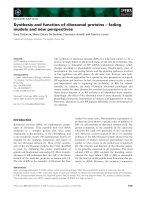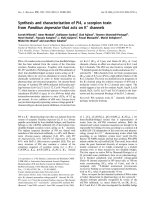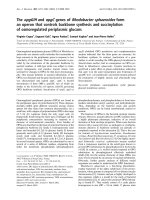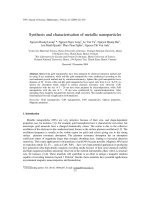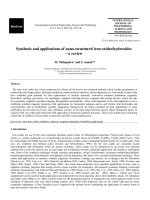Synthesis and Applications of TitaniumOxide Nanotubes
Bạn đang xem bản rút gọn của tài liệu. Xem và tải ngay bản đầy đủ của tài liệu tại đây (3.81 MB, 17 trang )
2
Synthesis and Applications of Titanium
Oxide Nanotubes
Tohru Sekino
Institute of Multidisciplinary Research for Advanced Materials (IMRAM), Tohoku
University, Aoba-ku, Sendai 980-8577, Japan
Abstract Titanium oxide nanotube (TiO
2
nanotube, TNT) is synthesized by the
low-temperature solution chemical method via the self-organization to form unique
open-end nanotubular morphology with typically 8–10 and 5–7nm in outer and
inner diameters, respectively. Because of the mutual and synergy combination of its
low-dimensional nanostructure and physical-chemical characteristics of TiO
2
semi-
conductor, properties enhancements and novel functionalization are expected in the
TiO
2
nanotube. In this chapter, synthesis, nanostructures, formation mechanism,
various physicochemical characteristics, and prospects of future application for the
TiO
2
nanotube are described in detail. In such an oxide material, property control
and enhancement is possible by tuning appropriate chemical compositions, crystal
structures, and composite structures. Therefore, special emphasis is also placed to
introduce modification of the nanotubes by doping and/or nanocompositing to meet
the requirements as for the environmental friendly and energy creation systems and
various functional devices.
2.1 Introduction
After the discovery of carbon nanotube (CNT) [1], large attention has been
paid to this unique low-dimensional nanostructured material because of its
attractive various physical and chemical functions which arise from the syn-
ergy of low-dimensional nanostructure and anisotropy of carbon network, thus
known as graphene structure. Till now, large numbers of not only funda-
mental studies on the structure, electrical, optical, mechanical, and physico-
chemical properties but also application-oriented research and development,
such as single-electron transistor device, field emission device, fuel cells, and
strengthening fillers of composites, have been extensively carried out. Besides
CNTs, various inorganic nanotubular materials have been reported in non-
oxide compounds, boron nitride (BN) [2] and molybdenum disulfide (MoSi
2
)
[3]; in oxides such as vanadium oxide (V
2
O
5
) [4–6], aluminum oxide (Al
2
O
3
)
[6], silicon dioxide (SiO
2
) [6, 7], titanium oxide (TiO
2
) [8–14]; and also in
natural minerals like imogolite [15, 16].
T. Kijima (Ed.): Inorganic and Metallic Nanotubular Materials.
Topics in Applied Physics 117, 17–32 (2010)
DOI 10.1007/978-3-642-03622-4
2
c
Springer-Verlag Berlin Heidelberg 2010
18 Tohru Sekino
Except natural mineral materials, fabrication of nanotubes is roughly clas-
sified into two methods; one is the template or replica method, in which some
template materials are used to form tubular structure. Many efforts have
been paid to fabricate tubular materials including nanotubes by attempt-
ing the template/replica method [4, 5, 8, 12–14]. The other one is based
on the self-structuralization or self-organization of matter during chemical
or physical synthesis/fabrication processes. Synthetic imogolite [16], sol–gel-
derived SiO
2
nanotube [7], chemically prepared TiO
2
nanotube [9, 10], and
nanotube/nanohole arrays such as Al
2
O
3
[17, 18] and TiO
2
[11, 19] prepared
by electrochemically using anodic oxidation of metal films are the typical sys-
tems fabricated by the self-organizing process.
Among them, titanium oxide nanotube (TiO
2
nanotube, TNT) is one
of the promising nanostructured oxides with tubular structure. TiO
2
is well
known as a wide gap semiconductor oxide. It is, however, inexpensive, chem-
ically stable, and harmless and has no absorption in the visible light region.
Instead, it is UV light responsible; electron and hole pair is generated by
the UV irradiation, inducing chemical reactions at the surface. Therefore, the
most promising characteristic of TiO
2
lies in its photochemical properties such
as high photocatalytic activity. Due to this reason, it has been widely studied
by many researchers from 1950s to utilize TiO
2
as a photocatalyst [20–22], an
electrode of dye-sensitized solar cell [23], a gas sensor [24], and so on.
On the other hand, Kasuga et al. [9, 10] have succeeded in the synthesis
of nanotubular TiO
2
, which has open-end structure with typically 8–10 and
5–7 nm in outer and inner diameters, respectively, using a simple and low
temperature solution chemical processing. Various methods such as anodizing
of metal substrates [11, 19], replica [8, 12, 13], and template methods [14] have
been investigated to prepare tubular TiO
2
. However, the synthesis method
developed by Kasuga et al. is based on a self-organizing and templateless route
that is achieved by low temperature process to form nanometer-sized tubular
morphology. Using this so-called Kasuga method, many related investigations
have been extensively carried out on structural analysis, process optimization,
properties evaluation, and so on [25–27].
As mentioned above, not only fundamental interests in the formation
mechanism and the unique nanotubular structures but also functions’ en-
hancements and novel functionalization are hence expected in the TiO
2
nan-
otube because of the mutual and synergy combination of various factors lying
in a nanotubular semiconductor: (1) crystal structure, (2) chemical bonding
and (3) physical/chemical properties of the matter, and (4) low-dimensional
nanostructures/nanospace/nanosurface and (5) self-organization/ordering of
the structure.
In this chapter, synthesis processing, nanostructures, various properties
and prospects of future application for the TiO
2
nanotube fabricated by
the low temperature solution chemical route are described in detail. In such
an oxide material, property control and enhancement are possible by tuning
appropriate chemical compositions and crystal structures. Therefore, special
2 Synthesis and Applications of Titanium Oxide Nanotubes 19
emphasis is also placed to introduce modification of the nanotubes by dop-
ing and/or nanocompositing in order to meet the requirements as per the
environmental friendly and energy creation systems and various functional
devices.
2.2 Synthesis and Structure of Titanium
Oxide Nanotubes
As mentioned before, fabrication of nanotubular TiO
2
is classified into two
methods: template/replica route [8, 12–14] and direct synthesis (i.e., template-
less) route. In the former method, some materials, such as organic, inorganic,
and metal nanowires/nanorods/whiskers or nanotube/nanohole arrays such as
Al
2
O
3
prepared by anodic oxidation of Al foil, are used as the templates. TiO
2
is hence often synthesized by sol–gel or precipitation methods in solution, and
then the templates are removed afterward. Therefore, the size of obtained
materials can be easily controlled by the size of template used. Followed by
these processing routes, however, the most as-synthesized nanotubes have an
amorphous structure, and then they become nanocrystalline nanotubes after
appropriate heat treatment.
The latter (direct) synthesis route includes low temperature solution chem-
ical method [9, 10] and electrochemical oxidation route from metal sub-
strate or foil, i.e., anodic oxidation of titanium or titanium alloy [19] that
also gives amorphous nanotubes. In the case of solution chemical route,
crystalline TiO
2
nanotube based on the TiO
6
octahedron network can be
obtained. In this section processing and structures of the TNT will be
given.
2.2.1 Low Temperature Solution Chemical Processing
Typical TNT is synthesized by the solution chemical route using high-
concentration alkaline solution [9, 10]. Various titanium oxide powders in-
cluding anatase- or rutile-type titania, their mixture, or titanium alkoxide
can be used as the source materials of TNT. The raw material is refluxed in
10 M NaOH aqueous solution at around 110
◦
C for 20 h or longer. The re-
sultant product is washed many times by distilled water in order to remove
sodium. Then 0.1 M HCl aqueous solution is added to neutralize the solution
and again treated with distilled water until the solution conductivity reached
5 mS/cm. The product is then separated by filtering, centrifugation, or freeze
drying technique and dried.
This synthesis is carried out under the refluxing condition so that the
pressure during synthesis is the same as that of ambient atmospheric pressure
of 0.1 MPa; the synthesis temperature of around 110
◦
C thus corresponds to
the boiling temperature of high-concentration alkaline solution.
20 Tohru Sekino
On the contrary, hydrothermal synthesis using an autoclave, which pro-
vides closed reaction environment and hence the slightly higher pressure dur-
ing the processing, can also be attempted to synthesize TNT [28]. Further-
more, not only TiO
2
but also Ti metal can be used as the source material
of TNT [29], in which process titanium is chemically oxidized in the alkaline
solution. The size control of TNT also has attracted much attention. Vari-
ous sized, especially thick TNT can often be synthesized by the hydrothermal
method, because it gives higher synthesis temperature than 110
◦
C. In ad-
dition, natural mineral source is also used for the TNT synthesis that may
reduce the production cost of the TNT [30].
X-ray diffraction patterns showing phase development during the chemi-
cal processing are shown in Fig. 2.1, and corresponding transmission electron
micrographs are represented in Fig. 2.2. After alkaline treatment, the product
mainly consists of amorphous and crystalline phase corresponding to sodium
titanate (Na
2
TiO
3
, Fig. 2.1b), but the shapeless matter is obtained (Fig. 2.2a).
After the water and HCl treatment (Figs. 2.1c and 2.2b), sodium titanate
disappears completely and another crystalline phase with low crystallinity is
observed. In this step, nanometer-sized sheet-like morphology can be obtained,
which is considered as the TiO
2
nanosheet. Further, water washing provides
fibrous product (Fig. 2.2c) with the length of several hundreds to several mi-
crometers. Higher magnification TEM photograph shown in Fig. 2.2d clearly
reveals that the outer and inner diameter of the final product is around 8–10
and 5–7 nm, respectively, and it has an open-end structure. The size of ob-
tained TNT does not depend on the kind of raw materials used. In addition,
when KOH is used as a reaction solution, TNT can also be produced with the
similar size and morphology.
Fig. 2.1. X-ray diffraction patterns of products obtained in each chemical synthesis
step: (a) anatase-type TiO
2
raw material, (b) after alkaline reflux (10 M NaOH,
110
◦
C, 24 h), (c) after water washing, (d) final product (after 0.1 M HCl and water
washing)
2 Synthesis and Applications of Titanium Oxide Nanotubes 21
Fig. 2.2. TEM images showing morphological development of the products in each
chemical synthesis step: (a) after alkaline reflux (10 M NaOH, 110
◦
C, 24 h), (b) after
0.1 M HCl treatment, (c) final product, (d) high magnification image of obtained
nanotubes
The surface area of the typical TNT is approximately 300∼ 350 m
2
/g,
and the value is in good agreement with the calculated theoretical surface
area, 345 m
2
/g, by assuming the tubular structure, the observed size, and the
density of TiO
2
crystal. However, recent investigation has revealed that the
larger TNT with more than 10 nm in diameter can be obtained when larger
titanium oxide powders with particle diameter in micrometer is used and when
hydrothermal synthesis method is utilized.
2.2.2 Nanostructures and Formation Mechanism
On the contrary to layered compounds like graphite, TiO
2
has rigid crystal
structure in which a lattice spreads out isotropically and three dimension-
ally, so that its crystal shape is usually equiaxial. However, solution chemical
synthesis described above gives anisotropic and open-end nanotube structure
in TiO
2
. In order to identify the structural characteristic and also to under-
stand the formation mechanism of TNT in relation to its synthesis process,
much efforts for the structural analyses have been paid by using X-ray and
22 Tohru Sekino
Fig. 2.3. TEM image of TiO
2
nanotube bundle (a) and selected area electron
diffraction pattern (b)
neutron diffraction and high-resolution electron microscopy coupled with elec-
tron diffraction technique [9, 10, 28–39].
In the selected area electron diffraction (SAED) pattern of TNT bundle
(Fig. 2.3), some diffraction spots with belt-like spreading are found, which
is typically found in a fibrous compound. As summarized in Table 2.1, the
interplanar spacing (d-spacing) of spots a (a
), b (b
), and d (d
) correspond to
those of (101), (200), and (100) of typical anatase crystal of TiO
2
, respectively
[38]. From these facts, it is considered that the TNT basically has the similar
crystal structure as the anatase type of TiO
2
, and then the longitudinal direc-
tion of the nanotube corresponds to the a-axis [(100) direction] while the cross
section is parallel to the b-plane [(010) plane] of the anatase crystal. On the
other hand, the diffraction spot c (c
) provides the d-spacing of 0.87 nm, and
corresponds to the broad diffraction peak found at 2θ of around 9
◦
in the XRD
patterns of Fig. 2.1d, and also corresponds to the spacing of 0.88 nm at the
wall in Fig. 2.2d. The reflection of anatase crystal near to this value is (001)
with d =0.951 nm (Table 2.1); however, there is a slightly large deviation (ap-
proximately 8.5%) between these values and hence the spot c(c
) seems not
to correspond directly to the (001) of anatase structure. This large interpla-
nar distance is a typical characteristic in titanium oxide nanotube and closely
related to the formation of the structures as described in the latter part.
Thermogravimetry coupled with mass spectroscopic analysis for the as-
synthesized TNT exhibited the weight loss continued up to approximately
350
◦
C and detected major species was H
2
O. High-temperature XRD results
Table 2.1. Interplanar (d) spacing observed for TiO
2
nanotube bundle (Fig. 2.3)
and corresponding plane and d-spacing of anatase-type TiO
2
Position d (nm) Anatase TiO
2
, hkl/d (nm)
JCPDS
a ∼ a
0.37 (101)/0.352
b, b
0.19 (200)/0.189
d, d
0.28 (110)/0.268
c, c
0.87 (001)/0.951
2 Synthesis and Applications of Titanium Oxide Nanotubes 23
Fig. 2.4. High-temperature X-ray diffraction patterns of synthesized TiO
2
nanotubes and corresponding structure change
(Fig. 2.4) demonstrated that the typical diffraction peak intensity found at
2θ around 9
◦
decreased with increasing in test temperature up to around
400
◦
C, while the peaks corresponding to anatase structure of TiO
2
became
to be the major crystalline phase and its crystallinity increased above the
temperature. Annealing temperature dependency of the specific surface area
for pure TNT is summarized in Table 2.2 (see also Fig. 2.8). High surface area
was maintained up to around 400
◦
C while sudden decrease occurred above
the temperature and then reached to the value approximately 100 m
2
/g at
an annealing temperature higher than 450
◦
C. From TEM investigation for
the annealed TNT, its nanotubular structure was found to be kept up to
around 450
◦
C. These facts imply us that the as-synthesized TNT contains
some amount of hydroxyl group (–OH) and/or structure water (H
2
O) and
has TiO
6
octahedral network structure which is similar to common anatase-
type structure of TiO
2
crystal or, in another words, has titanate-like structure
[38]. By the heat treatment (annealing) for the as-synthesized TNT, proton
is released as H
2
O and then the nanotube becomes to be the stoichiometric
Table 2.2. Variation of surface area on the annealing temperature for the TiO
2
nanotubes. The surface area is measured by the BET method
Temperature (
◦
C) RT 200 400 450 500 550
Surface area (m
2
/g) 322 308 228 123 101 95.0
24 Tohru Sekino
Fig. 2.5. (010) projection of H
2
Ti
3
O
7
unit cell (a) and structure model of nanotube
by assuming a chemical composition as H
2
Ti
3
O
7
(b and c) proposed by Chen et al.
[31]. Reprinted with permission from [31]
TiO
2
nanotube with an anatase structure as its base crystal structures at
around 400
◦
C.
Detailed structure analyses have been carried out extensively. Chen et al.
[31] investigated the structure of chemically prepared TNT by using high-
resolution transmission electron microscopy and reported that the TNT was
titanate with the chemical formula of H
2
Ti
3
O
7
and proposed the structure
model as shown in Fig. 2.5. On the other hand, Ma et al. [32, 33] showed it was
lepidocrocite which was one of the defect-containing titanate with the formula
of H
x
Ti
2−x/4
x/4
O
4
. Besides these structures, various compositions were re-
ported, Na
2
Ti
2
O
4
(OH)
2
or its protonated titanate of H
2
Ti
2
O
4
(OH)
2
[34] and
H
2
Ti
4
O
9
[35]. These compounds, however, basically contain OH group and/or
H
2
O and can be described as (TiO
2
)
n
·(H
2
O)
m
, which reasonably explains the
fact that H
2
O is released by the heat treatment of as-synthesized TNT as
mentioned above. The reason why many plausible composition models are
reported is considered as follows; synthesized TNT usually has a small di-
ameter and hence the wall thickness is quite thin, around 1–2 nm, and also
its crystallinity is rather low as shown in Fig. 2.1 by comparing with usual
TiO
2
crystalline particles. Furthermore, a large number of titanates are known
in the series, and most of them have a layered structure with the similar
structure.
As mentioned before, TNT can be fabricated by using not only NaOH
but also KOH, while the nanotubular matter is not synthesized in the case
of LiOH solution; in this case more stable crystalline LiTiO
2
is formed [38].
These facts imply us that the formation of alkaline titanate like Na
2
TiO
3
or
its amorphous matter (see Fig. 2.1b) is an important intermediate compound
2 Synthesis and Applications of Titanium Oxide Nanotubes 25
for the formation of the nanotube. By considering these facts the formation of
the TNT is thus regarded as follows: at first, titanate-containing alkali metals
(alkali titanates) is formed during the solution chemical treatment. Then the
alkali metal element is ion exchanged, and protonated titanate is formed as a
nanosheet. In the final step, the nanosheet converts to be a tubular structure
(Fig. 2.5) by scrolling process in order to lower the surface energy.
Till now a large number of discussions on the actual structure models
and formation mechanisms for the TiO
2
nanotubes [37–39], and related inves-
tigations such as process development for controlling nanotubes length and
diameter and extended research toward nanowires/nanorods, are continued
by many research groups. Nevertheless, it should be noted that the crystal
structure based on the three-dimensional framework of TiO
6
polyhedron and
low-dimensional nanostructure formation for the TiO
2
nanotube is a quite
unique and different from those of the carbon nanotube, which is built from
the two-dimensional graphene sheet (carbon network).
2.3 Functions of Titanium Oxide Nanotubes
Similar to common TiO
2
powder, the TNT is also white colored powder. The
optical bandgap energy calculated from the ultraviolet–visible light absorp-
tion spectra by assuming indirect transition of TiO
2
is approximately 3.41
∼ 3.45 eV for chemically synthesized TNT [38], which value is slightly larger
than that of anatase (3.2 eV) and rutile (3.0 eV) crystals. This blue shift of the
absorption edge wavelength is attributed to the quantum size effect of TiO
2
semiconductor [40] in TNT because of very thin nanotube wall thickness of
around 1 ∼ 2 nm. Recent materials design strategy of TiO
2
nanoparticles fo-
cuses on the developed visible light responsible TiO
2
photocatalyst [41] so
that the enlarged bandgap seems to be disadvantageous; nevertheless TNT
exhibits unique and excellent photochemical properties which contribute en-
hanced environmental purification performance.
2.3.1 Photochemical Properties and Photocatalytic Functions
In order to clarify the photochemical characteristic of TNT, Tachikawa et al.
[42] investigated the photocatalytic one-electron oxidation reaction of an or-
ganic molecule and related charge recombination dynamics during UV light
irradiation on TNT using time-resolved diffuse reflectance spectroscopy. They
observed remarkably long-lived radical cation and trapped e
−
for the TNT, ap-
proximately five times or more long lifetime than those for the nanoparticles.
Further, they have observed that the electron generated by the steady-state
irradiation of UV light could exist for longer time on the TNT surface, which
phenomenon was usually not confirmed in TiO
2
nanoparticles, and also the
evidence of rapid reaction of trapped e
−
with organic halide pollutants such as
CCl
4
. These features are considered mainly due to the unique one-dimensional
26 Tohru Sekino
nanostructure of the TNT and are the reason of the good photocatalytic prop-
erties; TNT has very thin wall so that generated carriers can effectively move
to the surface, and then charge recombination is inhibited due to its long
one-dimensional structure, clearly suggesting morphological advantage of the
TNT on the charge recombination dynamics. These may also be advantageous
for the use of TNT as for the electrode of solar cell in which transfer charac-
teristic is very important. In fact, longer lifetime while the similar diffusion
coefficient of electron in TNT has been reported when it has used for the
electrode of dye-sensitized solar cell [43].
As mentioned before, anatase-type TiO
2
is well known as a promising pho-
tocatalytic material due to its photochemical characteristic. Figure 2.6 shows
variation of hydrogen generation by UV light irradiation to as-synthesized and
annealed TNTs and commercial TiO
2
nanoparticles in water/methanol mixed
solution (so-called water splitting test) [38]. As can be seen from the figure,
as-synthesized TNT shows lower photocatalytic activity than the commercial
TiO
2
powders (P-25 and ST01). This low activity is considered due to the
existence of many hydroxyls (–OH) and/or structural water (H
2
O) and low
crystallinity of the as-synthesized TNT. On the other hand, annealed (400
◦
C)
TNT can generate approximately two to three times higher amount of H
2
than
that of nanoparticles, when compared to H
2
amount per unit mass of TiO
2
photocatalyst. The enhanced hydrogen evolution performance of the annealed
TNT is caused by the improved crystallinity (see Fig. 2.4) with maintaining
its nanotubular structure and higher surface area, around 230 m
2
/g (Table 2.2
and Fig. 2.8), than that of TiO
2
nanoparticle (approximately 50 m
2
/g). How-
ever, by comparing the generated amount of H
2
per unit surface area of the
catalysts, TNT exhibits around 44–65 % of nanoparticle system. This fact
indicates that an approximately half of the surface may not act as for the
active site of hydrogen generation, and hence the inner wall of the nanotube
Fig. 2.6. Hydrogen generation by the water splitting during UV irradiation to
various TiO
2
photocatalysts (P-25 and ST01, commercial TiO
2
nanopowders, as-
prepared TNT, and annealed TNT at 400
◦
C)
2 Synthesis and Applications of Titanium Oxide Nanotubes 27
may not contribute to the photocatalytic reaction, which is probably due to
the diffusion limit of molecules within the inner part of the nanotubes during
the reaction. Nevertheless, it is expected that the TNT would be one of the
promising candidate as the high-performance energy creation materials and
systems such as the excellent hydrogen generation catalyst.
2.3.2 Novel Environmental Purification Functions
Photocatalytic performance is often evaluated by the removal test of organic
molecules in water system. Figure 2.7 represents the variation of methylene
blue (MB) concentration in TiO
2
dispersed water system under dark and UV
light irradiation conditions. In the case of commercial TiO
2
nanoparticles, MB
concentration is quickly decreased under UV irradiation while is not changed
without the UV irradiation (hence under the dark condition). This clearly
indicates that the TiO
2
nanopowder is an excellent photocatalyst. However, in
the case of as-synthesized TNT, MB decrease can be confirmed even under the
dark condition and is enhanced further under the UV light irradiation. This
fact indicates that the TNT has a molecule adsorption characteristic, and it is
more obvious than the photocatalytic degradation under the UV irradiation.
When TNT is annealed, the MB degradation under the dark condition is
reduced; however, the photodegradation is higher than that of as-synthesized
TNT. It is again considered that the increased crystallinity can enhance its
photocatalytic performance.
Generally, TiO
2
including nanopowder has very low molecule adsorption
capability compared to typical adsorbent materials such as zeolite, activated
carbon, and clay minerals. Therefore, development of composite materials
of TiO
2
photocatalyst and some other adsorbents such as mesoporous silica
Fig. 2.7. Variation of methylene blue concentration under the dark and UV
light irradiation conditions for the TiO
2
nanoparticle, as-synthesized and an-
nealed TiO
2
nanotubes dispersed water system, and schematic drawing of adsorp-
tion/photochemical behaviors for the TNT
28 Tohru Sekino
[44] has been investigated. On the other hand, TNT has not only excellent
photocatalytic property but also high capability for the molecule adsorption
as a single phase material. This novel multifunctionality, hence the synergy of
molecule adsorption and photocatalytic properties, is attributed to its unique
crystal and nanostructures as well as material’s photochemical characteristic;
as described before, TNT has a high surface area and layered compound-like
structure such as clay minerals. These structural characteristics might be the
reason of the high adsorption capability of the TiO
2
nanotube. Therefore,
TNT is regarded as a novel multifunctional nanostructured material and then
expected to be an excellent candidate as for the advanced high-performance
environmental purification system.
2.3.3 Multi-functionalized Titanium Oxide Nanotubes
In order to enhance properties and/or to functionalize materials, doping some
elements and/or compositing with the other materials is often utilized. For
instance, doping to silicon can control its semiconductive properties and hence
various devices are widely developed and used. In the case of TiO
2
nanotube,
these are also applicable techniques. For instance, when TNT is considered
to be used as the chemical sensing device, electrode of solar cell, and so on,
control and improvement of electrical properties are necessary and required to
obtain higher conductivity, i.e., good carrier transfer properties and resultant
better device performance. For this purpose, various metal cations have been
doped into TNT via the chemical synthesis process [45]. When transition metal
cations such as Cr
3+
,Mn
3+
,Co
2+
,Nb
5+
, and V
5+
were doped, morphology,
surface area, and optical bandgap of the doped TNT were almost as same
as those of pure TNT. However, electrical conductivity of the doped TNT
was around 1–2 orders of magnitude higher, for example, 1.0 ×10
−4
S/cm for
0.08 mol% Cr-doped TNT, than those of TiO
2
nanopowder (2.6 ×10
−6
S/cm)
or pure TNT (3.0 × 10
−6
S/cm).
Another effect of cation doping to the TNT was found in the thermal
stability improvement as shown in Fig. 2.8; structural degradation of the nan-
otube and the resultant decrease of surface area began at around 400
◦
Cfor
the pure TNT (refer also to Table 2.2). However, the critical temperature was
enhanced approximately 50 (Mn
3+
,Co
2+
,Nb
5+
,V
5+
) to 100
◦
C (Cr
3+
)for
the doped TNT [38]. These facts indicate that the cation doping can enhance
both electrical conductivity and thermal stability of the nanotube, which is
regarded as one of the advantages when the TNT will be used as various
devices, because most of these devices are fabricated by the pasting and the
following sintering of the material to form films on the appropriate substrates.
Furthermore, loading various metals and/or compounds into inside of the
nanotubes and/or onto the surfaces in nanometer scale is possible. Figure 2.9
shows TEM images of metals and sulfide compound-loaded TNT nanocom-
posites which were prepared by using various physicochemical processing.
2 Synthesis and Applications of Titanium Oxide Nanotubes 29
Fig. 2.8. Temperature dependence of BET surface area of cation-doped TNTs
(cation concentration ca. ∼ 0.1 mol%) and corresponding morphology change for
pure and Cr-doped TNTs at 500
◦
C
Fig. 2.9. Various TNT-metal nanocomposites. (a) Pd-loaded TNT prepared by
sonochemical method, (b) Ag nanoparticles formed inside of the TNT, (c)Ni
nanoparticles inside of the TNT, (d) ZnS-loaded TNT prepared by solution chemical
route
30 Tohru Sekino
When Pd nanoparticles are composed with the TNT, hydrogen generation
performance was much enhanced due to the promoting effect of the loaded
noble metals [38]. For the properties enhancement and further multifunction-
alization, nanocompositing of TNT with the other materials is suitable and
advantageous method.
2.4 Conclusion and Prospects
In this chapter, chemical processing, structure, physical, and chemical prop-
erties of TiO
2
nanotube that can be prepared by the solution chemical
route have been reviewed. Till now, a large number of fundamental stud-
ies and application-oriented researches and developments are extensively car-
ried out by many researchers for this low-dimensional nanomaterial, because
not only enhancement of various properties of TiO
2
but also multifunction-
alization due to the harmonization of materials properties and unique low-
dimensional nanostructure is expected. As for the application of TNT, it has
been used as the oxide electrode of the dye-sensitized solar cell, and bet-
ter cell efficiency and structure-related characteristics on the charge trans-
port phenomenon have been reported [43]. Also it is reported that TNT
exhibits proton intercalation/de-intercalation and resultant electrochromism,
size-selective adsorption of molecules [46], anion doping to develop visible
light responsible TNTs [47], and biocompatibility [48, 49]. On the other hand,
extensive challenges to develop various oxide and compound nanotubes have
been continued. For instance, rare earth oxide nanotubes have recently been
synthesized [50]. (Details on the variety of nanotube materials are introduced
in other chapters.) All these facts imply us that the oxide nanotubes in-
cluding TNT have multifunctionalities owing to the structure–property cor-
relations. As mentioned before, one of the future research direction of the
TiO
2
nanotube might lie toward the application as the environmental and/or
energy creating systems, which would become more important in the near
future.
References
1. S. Iijima, Nature 354, 56–58 (1991).
2. N.G. Chopra, R.J. Luyken, K. Cherrey, V.H. Crespi, M.L. Cohen, S.G. Louie,
A. Zettl, Science 269, 966–68 (1995).
3. Y. Feldman, E. Wasserman, D.J. Srolovitz, R. Tenne, Science 267, 222–25
(1995).
4. M.E. Spahr, P. Bitterli, R. Nesper, M. M¨uler, F. Krumeich, H.U. Nissen, Angew.
Chem. Int. Ed. 37, 1263–1265 (1998).
5. P.M. Ajayan, O. Stephan, Ph. Redlich, C. Colliex, Nature 375, 564–567 (1995).
6. B.C. Satishkumar, A. Govindaraj, E.M. Vogl, L. Basumallick, C.N.R. Rao, J.
Mater. Res. 12(3), 604–606 (1997).
2 Synthesis and Applications of Titanium Oxide Nanotubes 31
7. H. Nakamura, Y. Matsui, J. Am. Chem. Soc. 117(9), 2651–2652 (1995).
8. P. Hoyer, Langmuir 12, 1411–1413 (1996).
9. T. Kasuga, M. Hiramatsu, A. Hoson, T. Sekino, K. Niihara, Langmuir 14, 3160–
3163 (1998).
10. T. Kasuga, M. Hiramatsu, A. Hoson, T. Sekino, K. Niihara, Adv. Mater. 11,
1307–1311 (1999).
11. D.Gong,C.A.Grimes,O.K.Varghese,W.Hu,R.S.Singh,Z.Chen,E.C.Dickey,
J. Mater. Res. 16, 3331–3334 (2001).
12. H. Masuda, K. Nishio, N. Baba, Jpn. J. Appl. Phys. 31, L1775–L1777 (1992)
13. P. Hoyer, Langmuir 12, 1411–1413 (1996).
14. H. Imai, Y. Takei, K. Shimizu, M. Matsuda, H. Hirashima, J. Mater. Chem. 9,
2971–2972 (1999).
15. N. Yoshinaga, S. Aomine, Soil Sci. Plant Nutr. 8(3), 114–121 (1962)
16. L.A. Bursill, J.L. Peng, L.N. Bourgeois, Philosophical Magazine A 80(1) 105–
117 (2000).
17. F. Keller, M.S. Hunter, D.L. Robinson, J. Electrochem. Soc. 100(9), 411–419
(1953).
18. S. Yamanaka, T. Hamaguchi, H. Muta, K. Kurosaki, M. Uno, J. Alloy. Comp.
373(1–2), 312–315 (2004).
19. V. Zwilling, E. Darque-Ceretti, A. Boutry-Forveille, D. David, M.Y. Perrin, M.
Aucouturier, Surf. Interface Anal. 27(7), 629–637 (1999).
20. S. Kato, F. Masuo, Kogyo Kagaku Zasshi, 67, 1136–1140 (1959). (in Japanese)
21. A. Fujishima, K. Hondam, Electrochemical photolysis of water at a semicon-
ductor electrode, Nature 238, 37–38 (1972).
22. A.L. Linsebigler, G. Lu, J.T. Yates, Chem. Rev. 95, 735–758 (1995).
23. B. O’Regan, M. Gr¨atzel, Nature 353, 737–739 (1991).
24. S. Hasegawa, Y. Sasaki, S. Matsuhara, Sens. Actuator B 13–14, 509–510 (1993).
25. G.H. Du, Q. Chen, R.C. Che, Z.Y. Yuan, L.M. Peng, Appl. Phys. Lett. 79,
3702–3704 (2001).
26. Q.H. Zhang, L.A. Gao, J. Sun, S. Zheng, Chem. Lett. 31, 226–227 (2002).
27. Y. Suzuki, S. Yoshikawa, J. Mater. Res. 19, 982–985 (2004).
28. Z Y. Yuan, B L. Su, Colloids Surf A, 241(1–3), 173–183 (2004).
29. A. Nakahira, W. Kato, M. Tamai, T. Isshiki, K. Nishio, H. Aritani, J. Mater.
Sci. 39, 4239–4245 (2004).
30. Y. Suzuki, S. Pavasupree, S. Yoshikawa, R. Kawahata, J. Mater. Res. 20, 1063–
1070 (2005).
31. Q. Chen, W.Z. Zhou, G.H. Du, L.M. Peng, Adv. Mater. 14, 1208–1211 (2002).
32. R.Ma,Y.Bando,T.Sasaki,Chem.Phys.Lett.380, 577–582 (2003).
33. R. Ma, K. Fukuda, T. Sasaki, M. Osada, Y. Bando, J. Phys. Chem. B 109,
6210–6214 (2005).
34. J.Yang,Z.Jin,X.Wang,W.Li,J.Zhang,S.Zhang,X.Guo,Z.Zhang,Darton
Trans. 91(20), 3898–3901 (2003).
35. A. Nakahira, W. Kato, M. Tamai, T. Isshiki, K. Nishio, H. Aritani, J. Mater.
Sci. 39, 4239–4245 (2004).
36. Y. Suzuki, S. Yoshikawa: J. Mater. Res. 19
, 982–985 (2004).
37. B. Poudel, W.Z. Wang, C. Dames, J.Y. Huang, S. Kunwar, D.Z. Wang, D.
Banerjee, G. Chen, Z.F. Ren, Nanotechnology, 16, 1935–1940 (2005).
38. T. Sekino, Bull. Ceram. Soc. Jpn. 41(4), 261–271 (2006). (in Japanese)
39. D.V. Bavykin, J.M. Friedrich, F.C. Walsh, Adv. Mater. 18, 1–9 (2006).
32 Tohru Sekino
40. Y. Wang, N. Herron, J. Phys. Chem. 95, 525–532 (1991).
41. R. Asahi, T. Morikawa, T. Ohwaki, K. Aoki, Y. Taga, Science 293, 269–271
(2001).
42. T. Tachikawa, S. Tojo, M. Fujitsuka, T. Sekino, T. Majima, J. Phys. Chem. B
110, 14055–14059 (2006).
43. Y. Ohsaki, N. Masaki, T. Kitamura, Y. Wada, T. Okamoto, T. Sekino, K. Ni-
ihara, S. Yanagida, Phys. Chem. Chem. Phys. 7, 4157–4163 (2005).
44. K. Inumaru, T. Kasahara, M. Yasui, S. Yamanaka, Chem. Commun. 16, 2131–
2133 (2005).
45. T. Sekino, T. Okamoto, T. Kasuga, T. Kusunose, T. Nakayama, K. Niihara,
KeyEng.Mater.317–318, 251–254 (2006).
46. H. Tokudome, A. Shimai, Y. Mitsuya, Y. Tsuru, M. Miyauchi, Mater. Integra-
tion, 18(1), 31–35 (2005). (in Japanese)
47. H. Tokudome, M. Miyauchi, Chem. Lett. 33, 1108–1109 (2004)
48. T. Kasuga, Mater. Integration 18(1), 26–30 (2005). (in Japanese)
49. K. Sasaki, K. Asanuma, K. Johkura, T. Kasuga, Y. Okouchi, N. Ogiwara, S.
Kubota, R. Teng, L. Cui, X. Zhao, Ann. Anat. 188, 137–142 (2006).
50. M. Yada, M. Mihra, S. Mouri, M. Kuroki, T. Kijima, Adv. Mater. 14, 309–313
(2002).
Index
Ag nanoparticles in TNT, 29
Carbon nanotube (CNT) discovery, 17
Cation doping to TNT, 28
Direct synthesis of TNT, 19
Environmental purification functions
of TNT, 27–28
Formation mechanism of TNT, 21–25
High-temperature X-ray diffraction
patterns of synthesized TNT, 23
Hydrothermal synthesis of TNT, 20
Interplanar spacing in TNT, 22
Kasuga method, 18
Low temperature solution
chemical processing synthesis
of TNT, 18–21
Ni nanoparticles in TNT, 29
Pd-loaded TNT, 29
Photocatalytic functions of TNT, 25–27
Photochemical properties of TNT,
25–27
Selected area electron diffraction
(SAED) pattern of TNT, 22
Self-structuralization or self-
organization, 18
Surface area variation on annealing
temperature for TNT, 23
TEM images of TNT synthesis, 21–22
Temperature dependence of BET
surface area of cation-doped
TNTs, 29
Template or replica method, 18
Titanium oxide nanotube (TNT) mutual
and synergy combination, 18
Titanium oxide nanotube (TNT)
properties, 18
TNT-metal nanocomposites, 29
Water splitting test, 26
X-ray diffraction patterns of TNT
synthesis, 20
ZnS-loaded TNT, 29
/>

![Tài liệu Báo cáo khoa học: Specific targeting of a DNA-alkylating reagent to mitochondria Synthesis and characterization of [4-((11aS)-7-methoxy-1,2,3,11a-tetrahydro-5H-pyrrolo[2,1-c][1,4]benzodiazepin-5-on-8-oxy)butyl]-triphenylphosphonium iodide doc](https://media.store123doc.com/images/document/14/br/vp/medium_vpv1392870032.jpg)

